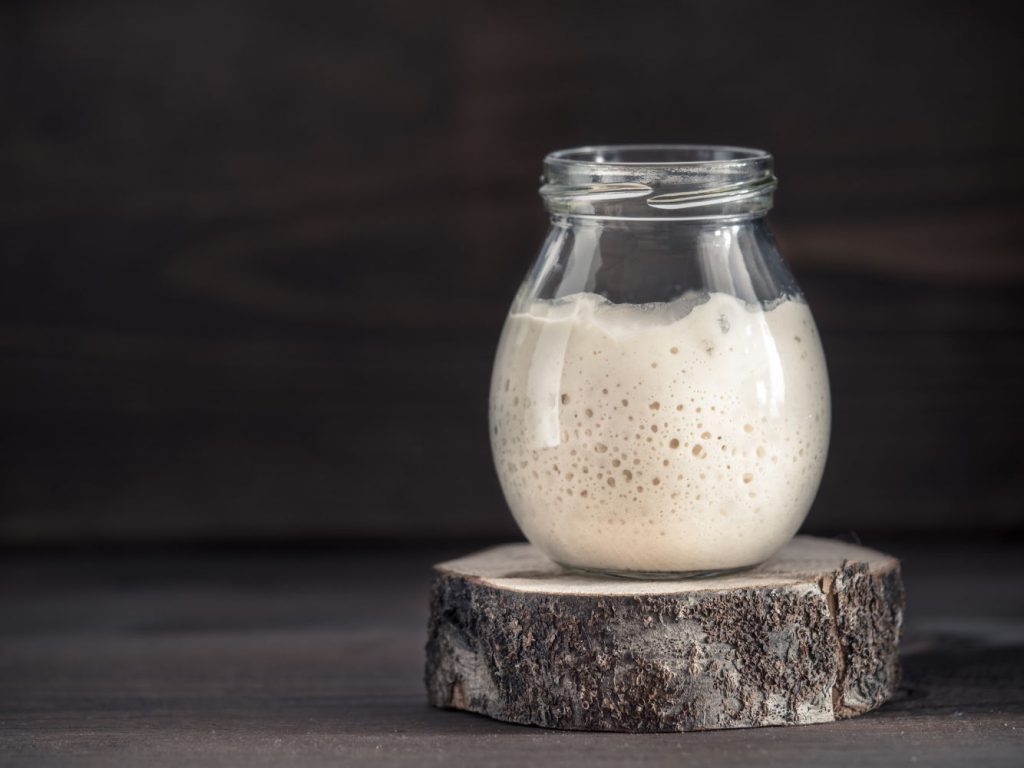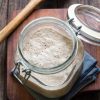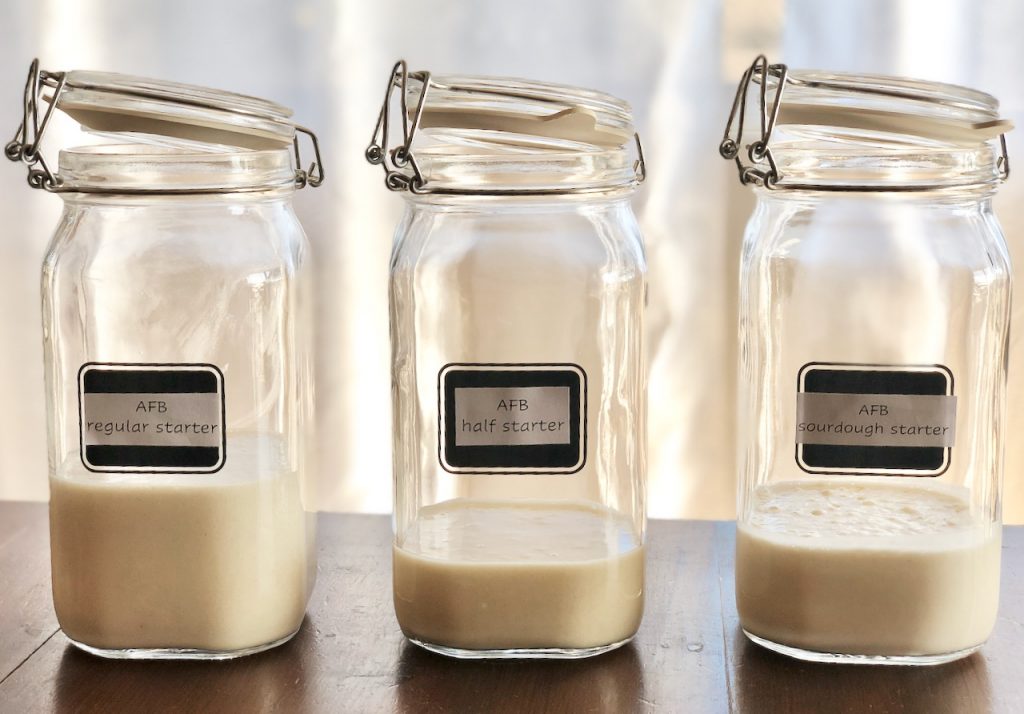
Wondering if you can use a traditional sourdough starter in lieu of Amish Friendship Bread starter in any of our 200+ recipes? Wondering what the difference is between a regular sourdough starter and an AFB starter?
I’ll take the second question first: in a nutshell, a sourdough starter is made of flour and water, and an Amish Friendship Bread starter is made is flour, sugar, and milk. An Amish Friendship Bread starter also uses commercial yeast to kick it off (unless you received your starter from a friend), whereas a traditional sourdough starter does not (if you want to use yeast to kick of your sourdough starter, check out my Easy Sourdough Starter recipe).
For the first question — can you substitute your sourdough starter for AFB? The answer is YES, but there are some caveats. You’ll want to experiment in the beginning, but once you’ve done it a few times, you’ll know what works for you (and what doesn’t).
Read This First
These are general guidelines for substituting 1 cup regular sourdough starter for 1 cup Amish Friendship Bread starter. Please remember that each recipe (and each starter) is different, so results may vary between kitchens and home bakers. Please note that the recipes in the Friendship Bread Kitchen are written primarily for Amish Friendship Bread starters, which is a sweet sourdough starter. You can adapt most of the recipes to accommodate a traditional sourdough starter, but I recommend taking notes and trying a starter swap with a simple recipe at first, like the original cinnamon-sugar Amish Friendship Bread.
Whenever anyone wants to substitute an ingredient in a recipe, my recommendation is this: make the recipe at least once as it is written. Some swaps are no brainers, but others could affect the final result. This means that, yes, you might want to consider starting an Amish Friendship Bread starter so you’ll know how to compare the two different starters in a recipe. The good news is, you can do that easily from your existing sourdough starter.
Recipes succeed due to a careful balance of ingredients, time and temperature. When you start to tinker with any of these elements, you risk a recipe not turning out as you had hoped.
If you’re ready to try a recipe in the Recipe Box and have a sourdough starter on hand, here are a few things to keep in mind.
Hydration Levels
Amish Friendship Bread starter is at 100% hydration, sometimes higher, never lower. If using a sourdough starter in place of an AFB starter, you’ll either use discard or a sourdough starter that’s just been fed at 100% hydration. Anything lower than 100% will be too thick for most recipes here, and you’ll need to adjust the liquid ingredients to compensate. Your starter should be pourable like a thick batter, but not runny.
An exception to this might be any of the more traditional sourdough loaves which may benefit from a lower hydration (more flour to liquid) starter. Experiment to find the right hydration for these recipes.
Sugar/Sweetness Factor
Amish Friendship Bread starter is sweeter than a traditional sourdough starter. The regular addition of milk and sugar helps feed the yeasts in the starter and also lends a mild, tangy sweetness to most recipes. Since a traditional sourdough starter contains no added sugars, you’ll need to adjust the sweetness factor for each recipe.
Recently Fed vs. Discard
For best results, use a starter that has just been fed, but you can also use your sourdough starter discard to make pancakes, waffles, cookies, crackers, most cakes, and breads that don’t require a rise.
Here are a few recipe categories that use 1 cup of Amish Friendship Bread starter:
- Biscotti and Crisps
- Biscuits and Buns
- Brownies
- Cakes
- Classic AFB and Sweet (Quick Bread) Variations
- Cookies
- Crusts and Cobblers
- Fun/Creative (pretzels, granola bars, pizza dough, crockpot and breadmaker variations)
- Muffins
- Pancakes and Waffles
- Scones (my absolute favorite way to use starter!)
- Sourdough loaves
Make an Amish Friendship Bread starter from your sourdough starter
If you’d like to make more recipes in my Recipe Box on a regular basis, consider making an Amish Friendship Bread starter from your sourdough starter. A lot of home bakers keep both on their counter, and it’s easy to get one going. Plus, it’s super easy to freeze Amish Friendship Bread starter or put on hold.


Resources:
- Discard 101: https://www.epicurious.com/expert-advice/do-you-really-have-to-discard-sourdough-starter-article
- Hydration 101: https://truesourdough.com/sourdough-hydration-explained-what-why-how-when/
- Freezing Amish Friendship Bread starter: https://www.friendshipbreadkitchen.com/tutorial-storing-amish-friendship-bread-starter-for-future-use/

Can I use leftover AFB to start a sourdough? I had some leftover AFB after dividing (1/2c leftover) and added equal flour/water to the jar and tried to start Sourdough that way. I am on day 6, and not sure what to do now. I hate to waste what progress I’ve done so far. Can I proceed as if I’m doing Amish Friendship Starter and just add 1C sugar since I’ve already added more flour and liquid than the 1C flour, 1C milk for Day6? Or just continue on with it as “sourdough” and feed daily until it doubles?
I have a traditional sourdough starter that I have had for more than 2 years originally made from wild yeasts not commercial. I kept a traditional AFB starter given to me by a friend for a while. About a year ago I used 1 cup of both and could not really tell any noticeable difference in the breads. Since then I have made many of the recipes on this site with just my sourdough starter and have not bothered to keep a traditional AFB starter since my original sourdough starter seems to do the trick. In fact, many of the non-sweet breads, crackers, etc. do better with traditional sourdough anyway.
I hope this helps with anyone considering using only a traditional sourdough starter in these AFB bread recipes.
Thanks for sharing, Eowyn! That’s awesome to hear that you’ve been enjoying our recipes with your traditional sourdough starter!
Hi, so I switched my regular starter to AFB starter using your recipe. My question is, after bake day and I use one cup, gift 1 cup and leave 1 cup on counter….Does that cup that I leave out on counter start back at day 6 or is it good to feed and bake at anytime going forward?
Hi Vicky! Here’s a great post about when you can bake with your starter after your first 10 day schedule: https://www.friendshipbreadkitchen.com/faq-how-soon-can-i-bake-use-my-amish-friendship-bread-sourdough-starter/ There are several different feeding schedules you can get on. However, the key is just being able to tell when it is hungry and feed it then (https://www.friendshipbreadkitchen.com/faq-how-often-should-i-feed-my-starter/)! Let us know if you have any other questions!
I received an Amish Friendship Bread starter and I’m excited to get to day 10 and bake it. However, I would like to keep a starter around. I’ve had a sourdough starter before which I’ve only fed with flour and water. Is it okay to keep this Amish starter going but treat it like sourdough starter? Will it eventually just act like regular sourdough? I’d prefer a non sweet starter anyway.
Hi Andrea! Yes, you can totally do this. Moving forward, maintain 1 cup starter equals 1 cup flour, 1 cup water. The only thing is that sourdough starters need to be fed a little more often, so keep an eye on your starter and feed accordingly. Have fun!
We are first timers (rookie alert!) and using AFB starter but hoping for some success with GF flour. When you are doing the weekly feeding and storing it in the fridge, can you feed it with the GF 1:1 Baking Flour for the same result? And after viewing the comment above – would you feed AFB with 1 cup water, 1 cup flour, plus 1 cup sugar? Thanks, your site is such a great resource!
Hi Audra! Welcome to the world of Amish Friendship Bread! Unfortunately, most gluten-free flours have had pretty mixed success rates. We do have a potato starter that doesn’t use flour, but other than that we haven’t found a gf flour that works well consistently. Let us know how your experience goes, though! Good luck!
Hi! I just successfully made a gf sourdough starter that may be transferable to an AFB starter! It’s superfine brown rice flour based. First day is 1 cup flour and 3/4 cup + 2 Tb water. Day 2-4 is 1/3 cup flour and 1/4 cup water (I had to start feeding every 12 hours because mine got hungry before 24hrs was up). On day 5 feed it the same amounts as day 1. After 12-24 hrs the starter is ready to be used! I just successfully used mine to make some savory sourdough crepes. I’m looking forward to trying to make some of the AFB recipes on this site!